Geek Articles
Experiments For Ultra High Resolution Camera Sensors
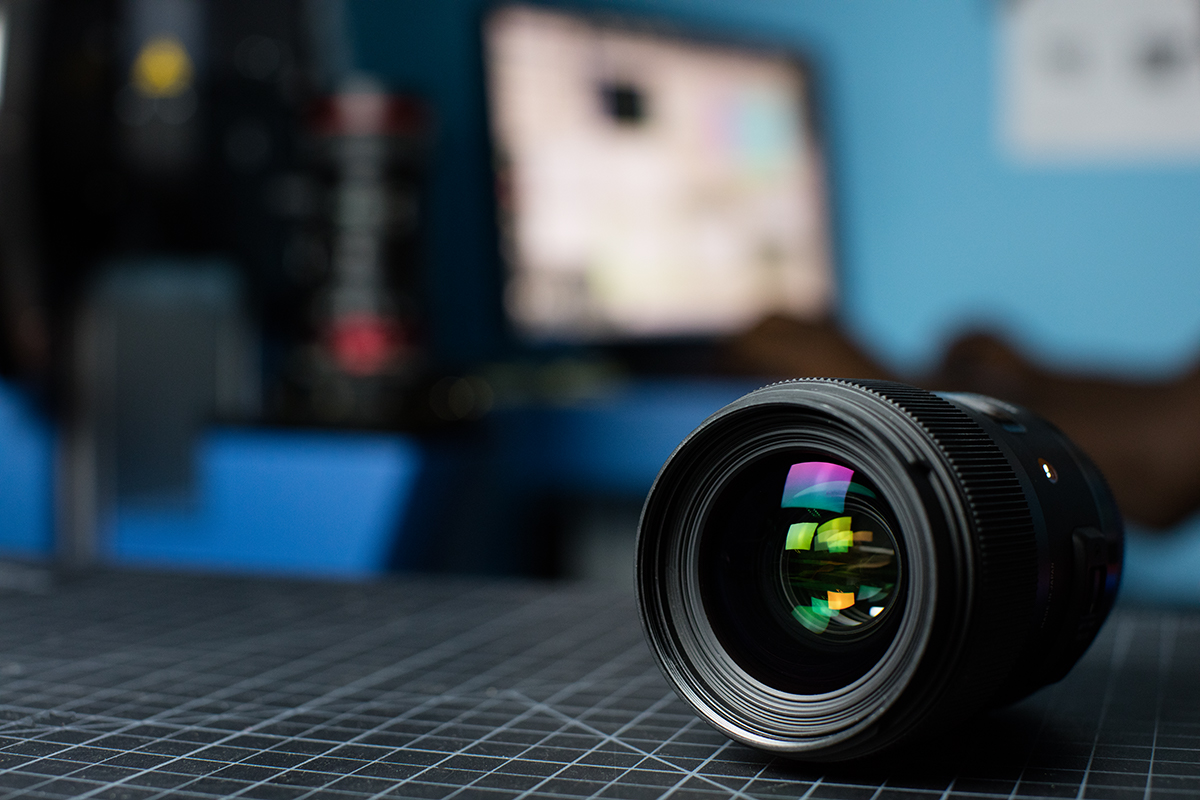
GEEK ALERT!!
Let’s be absolutely clear; this is not a useful article in regards to your technique. It won’t help your photography or videography become better. It won’t help you choose equipment any time in the next couple of years. It won’t provide any fodder for your next Forum War. It’s just a geek article that may interest some people. It may give a little peek into what may come in the future, and some insight into the kind of work we’re actually doing behind the scenes at Olaf. So if you’re interested in that kind of stuff, read along.
Let’s pretend, since if it happened, I’d be bound by nondisclosure agreements, that a company said, “We want to know which lenses can resolve 240 line pairs / mm.” Your first thought might be no you don’t, not unless you have a 150-megapixel sensor. And maybe they said they did.
You might, at first, make some suggestions off the top of your head. Then you might reconsider having made those suggestions because you realized that a lens that’s good at 50 line pairs/mm, which is where you test, might not even begin to resolve 200 line pairs/mm.
What is This Frequency of Which You Speak?
Higher frequency MTF correlates with fine detail resolution in images. We used to say that 10 line pairs was about how contrasty large objects appeared in the image; a low MTF (sort of) meant the edges were fuzzier.
So if my picture is of some chunky black and white bars, lower MTF means their fuzzier. You can probably sharpen those up in post processing real nicely and get sharp bars back.

Higher frequencies are like smaller, thinner bars closer together. If I blur them they don’t just get blurry, they bleed over each other and become a gray mess. If you sharpen up #3 below you don’t get your bars back; you get a gray box.

We can have spirited arguments for days about what frequencies show the resolution of small details in images. In the past, 30 or 40 line pairs/mm was considered high frequency. Today, with better lenses and higher megapixel bodies, we test up to 50 line pairs, and there is a legitimate argument about whether that is high enough. Some people think we should consider testing at 80 line pairs/mm.
Let me insert here that you can find lots of spirited arguments about what is ‘high resolution.’ I’m not getting involved; I have better things to do. BUT please, please, realize that someone using the terms MTF50 or MTF10 to measure line pairs is a very different thing than measuring the MTF frequency, so don’t try to pull a term from one argument into another argument.
Most of us realize that a higher resolution camera is going to make (almost) every lens resolve better. But if some lenses are going to wring more performance out of that high-resolution camera than others. If you want to find a lens that can wring every bit of performance possible, you use some fancy math and calculate out what frequency the camera sensor could resolve. Please note: if you think that’s a perceptual megapixel or something like that, you don’t need to be reading this. We’re trying to do science here.
You will be pleased to know that I won’t get into all the math of exactly how high a frequency is pertinent for three reasons. First, it would bore you. Second, there are too many arbitrary factors weighing in that decision. And third, I suck at math. But smart people who know way more theory and math than I do say such a camera might resolve up to 240 line pairs/mm. I don’t know much theoretical math, but I know common sense so I cut that back to 200 line pairs/mm and honestly I think that may be a little high for the real world.
But that’s still a way higher frequency than we’re used to testing at. And there are a lot of reasons to think that good performance at 50 line pairs/mm isn’t going to absolutely predict good performance at 200 line pairs /mm. I honestly wasn’t sure if any photo or video lens was going to resolve 200 line pairs/mm.
Another question was what MTF is adequate to consider it detectable by the camera. Satellite image detection software might detect an MTF of 0.1 (Image 3, above right, is an MTF of just under 0.1) but that’s not realistic for a color image. An MTF of 0.2 is probably the minimum necessary to ‘see’ and 0.3 would make me more comfortable (Image 2, above center, has an MTF of just over 0.3).
So we grabbed a bunch of what we considered good lenses and started testing them.
Well, Wide Open Isn’t the Answer
Let’s start (OK, by start, I mean start the article. We tested a lot of things, and these are just some examples of the best we found) by looking at a single copy of an excellent lens; the Zeiss 85mm f/1.4 Otus. Here are the results we usually test; from 10 to 50 line pairs/mm. That’s just exceptionally good.
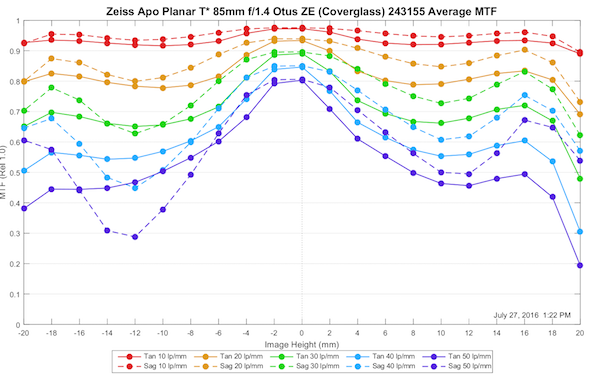
Olaf Optical Testing, 2017
Now let’s test another Zeiss 85mm f/1.4 Otus at 40, 80, 120, 160, and 200 line pairs/mm. First of all, let’s notice that this copy isn’t quite as good as the one in the first test. You can tell that because 40 line pairs (red in this graph below, light blue in the graph above) is not quite as high. More importantly for me, you can tell that both 160 and 200 line pairs (light blue and purple below) have an MTF less than 0.2.
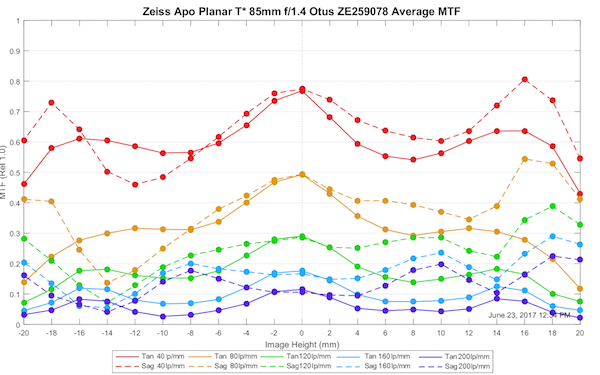
Olaf Optical Testing, 2017
I expected things would be worse with a wide-angle lens. Here is the excellent Sigma 35mm f/1.4 Art lens at standard testing.
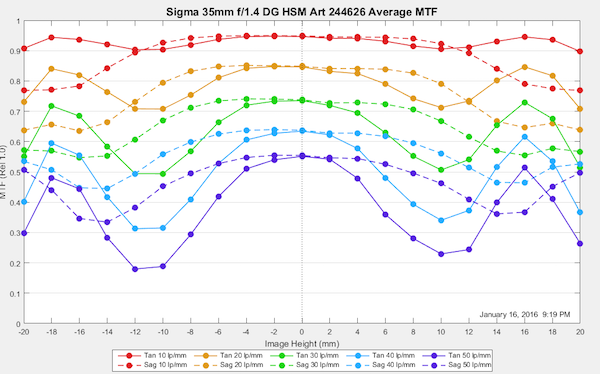
Olaf Optical Testing, 2017
And here tested at higher frequencies. But actually, the Sigma 35mm resolves, in the center at least, 160 line pairs with an MTF of 0.3 and even 200 line pairs has an MTF over 0.2.
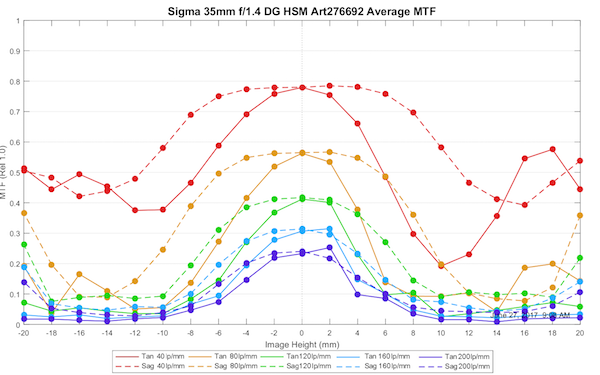
Olaf Optical Testing, 2017
This is as good as we saw in any lens at f/1.4 or f/2.0. But we did find if we stopped down a bit there definitely were some lenses that could resolve 200 line pairs /mm, at least in the center area of the image.
The Best We Found
This doesn’t mean it’s the best there are, but we checked several dozen likely candidates from Canon, Zeiss, Sigma, and number of Cinema lenses. This isn’t everything we tested, by a long shot, but it’s an overview of the better ones.
Sigma 135mm f/1.8 DG HSM Art at f/4
The Sigma was nearly this good at f/2.8, too. But we definitely have MTF > 0.3 in the center 1/3 of the image.
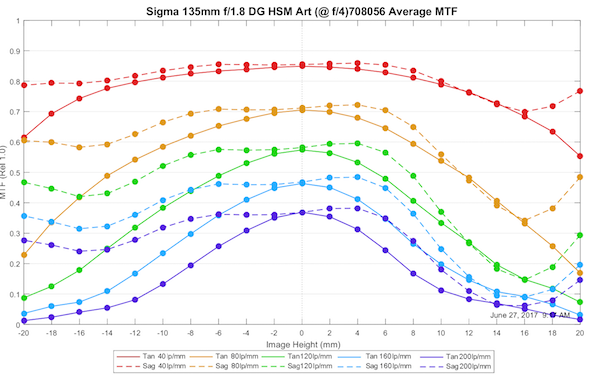
Olaf Optical Testing, 2017
Zeiss 135mm APO-Sonnar T 135mm f/2 at f/4
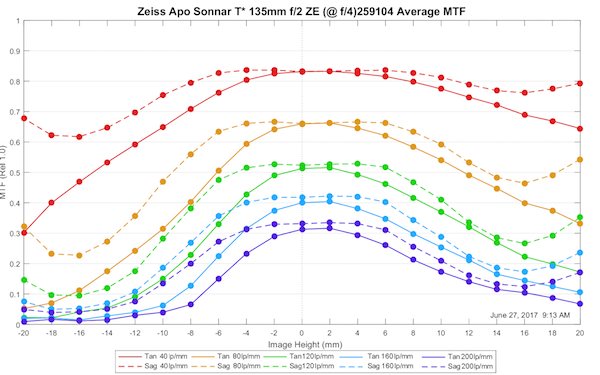
Olaf Optical Testing, 2017
It’s not quite as good as the Sigma but it still passes in the center, and this copy is a tiny bit decentered, perhaps. Nothing that showed at higher resolutions but it seems to here. We may find a copy that does better.
Zeiss APO-Planar T 85mm f/1.4 OTUS at f/4
The Otus was not only the best 85mm but arguably the best lens period at 200 lp/mm.
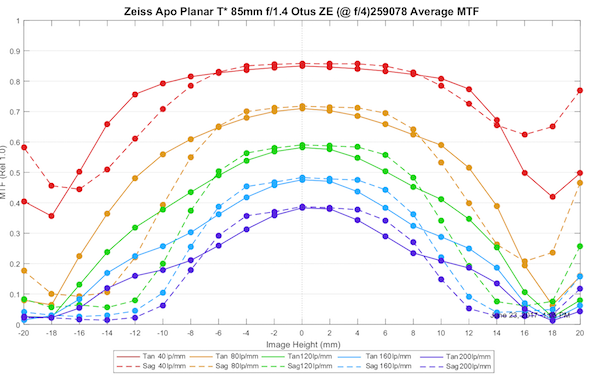
Olaf Optical Testing, 2017
Once we get wider than 85mm things get a little iffy. The Zeiss 55mm f/1.4 Otus was the only 50mm that looked as good as the above lenses, and it did it’s best at f/4.
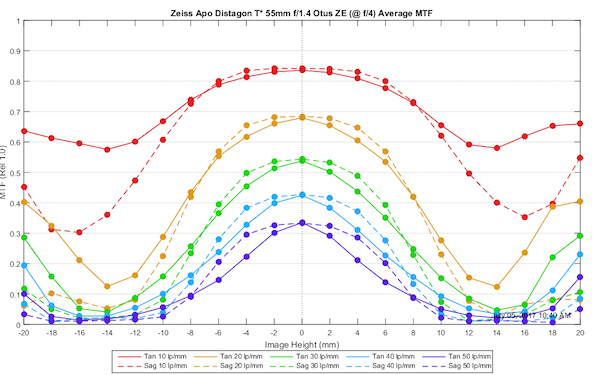
Olaf Optical Testing, 2017
At 35mm both the Canon 35mm f/1.4 Mk II and Sigma 35mm f/1.4 Art passed the screening criteria right in the center of the image, but not very far off axis.
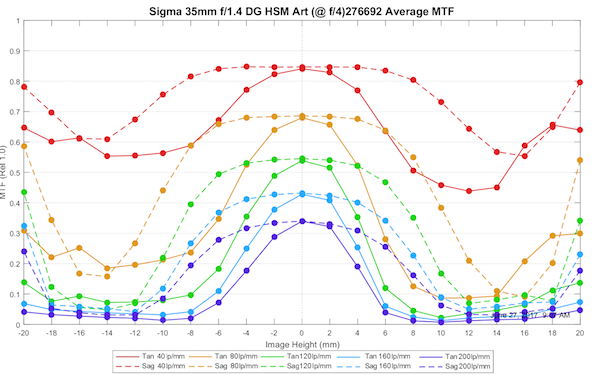
Olaf Optical Testing, 2017
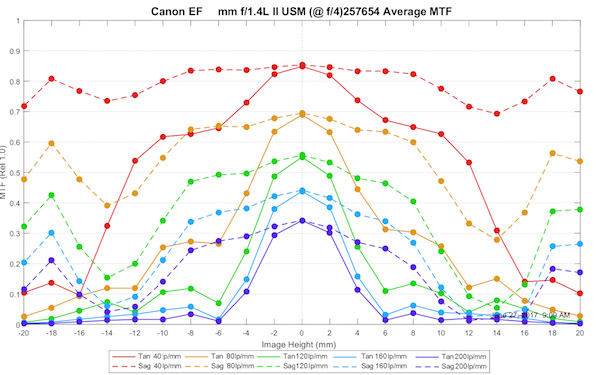
Olaf Optical Testing, 2017
Canon 24mm f/1.4 Mk II
We still have some wide testing to do, but of the wide angle primes we’ve tested so far, only the Canon 24mm f/1.4 Mk II reaches and MTF of 0.3 at 200 lp/mm, and only accomplishes that right in the center. And before you ask, yes, we tested it. Pretty much whatever you’re thinking of, we tested it.
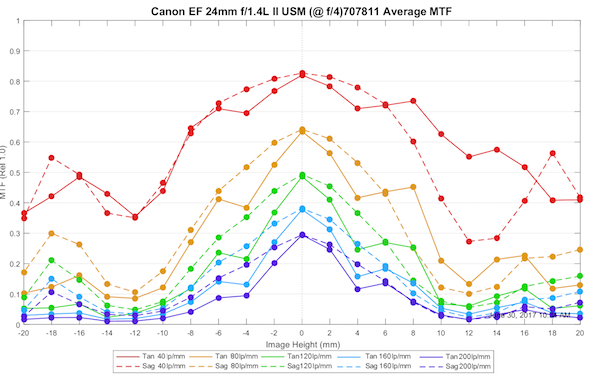
Olaf Optical Testing, 2017
The Surprise Lens
OK, this lens didn’t quite make our MTF > 0.3 cut-off, but it was very close. I put it up here because I like to point out that my mouth runs ahead of my brain sometimes. I said, complete with eye-rolling, that there was no need even to consider testing any zoom for this. But just for fun, we put a Canon 11-24mm f/4 L on the bench at 15mm. It did well enough to make me nervous because if a zoom had actually made it, I would have heard about it. Several times a day. For about a year.
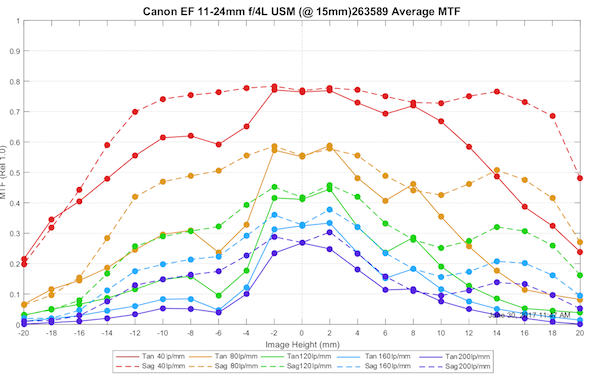
Olaf Optical Testing, 2017
So What Did We Learn Today?
Well, mostly nothing, but there are a couple of things.
First, let me emphasize again that if we had a 150-megapixel camera and shot today’s lenses on it, the images would have more detail than that same lens on your current 36-megapixel camera. How much more? It’s hard to say. But remember you have to roughly quadruple megapixels to double resolution. If you’re shooting a 36-megapixel camera, then a 150-megapixel camera would about double your potential resolution. You’d notice the difference, especially if you crop the hell out of an image or print billboards or something.
This test is looking at it from the other perspective; If you had this camera and wanted to see the finest detail possible, which lens would let you do that? Well, it’s borderline, but there are at least a few that seem reasonable choices. None of them do it at f/1.4 or even f/2, and none do it in the corners, but there are some that do it.
Is any of this important to you today? Not this specific issue, but it does demonstrate some of the scrambling that’s going on in with manufacturer’s testing. Most metrology (optical testing) used today was developed for film and for digital cameras of 12 to 16 megapixels. A lot of testing is also based on the fallacy that if a lens is good in the center, it will be good on the edges (that’s extremely false in the real world, but still widely accepted in the theoretical world).
Right now, many manufacturers are scrambling to improve their testing because a guy with a 36-megapixel camera taking pictures can see flaws that don’t show up on service-center testing. The amusing thing is that they’re still trying to catch up to today’s 36 and 50-megapixel resolution, but guess what? Higher resolution than that is coming. (For the 1,643 comments that will follow, I agree, 97% of us don’t need that resolution. But it’s coming anyway.)
This is going to play out even more dramatically in Cinema lenses. Remember what I said earlier, that you roughly get double the resolution if you quadruple the megapixels? Well, photo guy with his 50-megapixel camera is a little smug, knowing it will take 200 megapixels to double the resolution of his camera. But video guy that was shooting 1080p a couple of years ago (2.1 megapixels) just jumped up to 4k probably (9 megapixels). So he’s almost doubled resolution in this recent move. In a fairly short time, 8k will be here, and 8k is around 33 megapixels.
Wait, wasn’t 30 megapixels about where we found camera metrology, you know those test charts and lens projectors, weren’t adequate anymore? Yep, that would be correct. Of course, video metrologists aren’t much different than photo metrologists. They all tell me that a lens test projector and some test charts will be all the testing they could ever need. Forgive me, but I’ve heard this one before. But for the first time, we’re putting all video lenses on the optical bench. It wasn’t necessary before, and probably isn’t now, but it sure will be at 8k.
I’ll be doing some write ups on that soon, but here’s a spoiler: some video lenses that looked fine for 4K are a bit tilted or decentered when held to 8k standards. Believe me, I realize that video is about the look, and focus accuracy, color rendition and a lot of things other than resolution. But trust me, that slightly tilted field of focus that isn’t noticeable at 1080p just screams at you in 8k. Similarly, that ‘good enough parfocal for 1080p’ becomes not quite parfocal at 4k or 6k.
Roger Cicala and Aaron Closz
Lensrentals.com
July, 2017
Author: Roger Cicala
I’m Roger and I am the founder of Lensrentals.com. Hailed as one of the optic nerds here, I enjoy shooting collimated light through 30X microscope objectives in my spare time. When I do take real pictures I like using something different: a Medium format, or Pentax K1, or a Sony RX1R.
-
Alkind
-
vgrin
-
vgrin
-
Gianni Giannini
-
Carleton Foxx
-
Brandon Dube
-
Carleton Foxx
-
Brandon Dube
-
Arthur Meursault
-
K5TRX
-
Leo
-
DrJon
-
Roger Cicala
-
Brandon Dube
-
Brandon Dube
-
Arthur Meursault
-
Arthur Meursault
-
Arthur Meursault
-
Roger Cicala
-
DrJon
-
DrJon
-
Patrick Cligny
-
Omesh Singh
-
Omesh Singh
-
Greg Dunn
-
Leo
-
Arthur Meursault
-
Arthur Meursault
-
Justin
-
kirby2112
